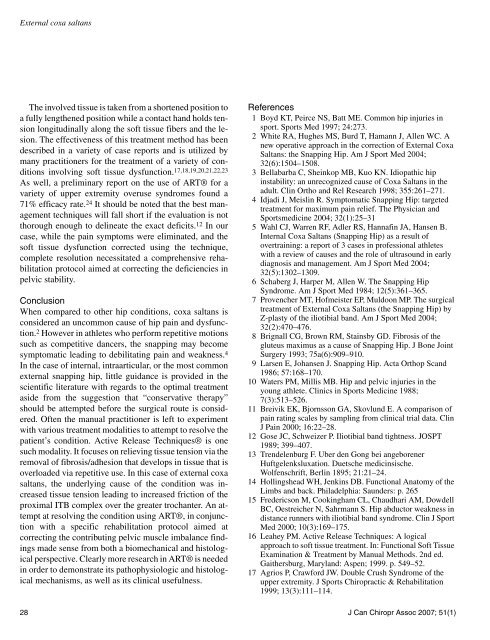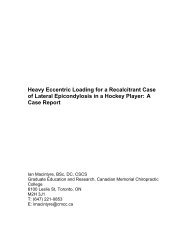External coxa saltans (snapping hip) - Journal of the Canadian ...
External coxa saltans (snapping hip) - Journal of the Canadian ...
External coxa saltans (snapping hip) - Journal of the Canadian ...
You also want an ePaper? Increase the reach of your titles
YUMPU automatically turns print PDFs into web optimized ePapers that Google loves.
<strong>External</strong> <strong>coxa</strong> <strong>saltans</strong><br />
The involved tissue is taken from a shortened position to<br />
a fully leng<strong>the</strong>ned position while a contact hand holds tension<br />
longitudinally along <strong>the</strong> s<strong>of</strong>t tissue fibers and <strong>the</strong> lesion.<br />
The effectiveness <strong>of</strong> this treatment method has been<br />
described in a variety <strong>of</strong> case reports and is utilized by<br />
many practitioners for <strong>the</strong> treatment <strong>of</strong> a variety <strong>of</strong> conditions<br />
involving s<strong>of</strong>t tissue dysfunction. 17,18,19,20,21,22,23<br />
As well, a preliminary report on <strong>the</strong> use <strong>of</strong> ART® for a<br />
variety <strong>of</strong> upper extremity overuse syndromes found a<br />
71% efficacy rate. 24 It should be noted that <strong>the</strong> best management<br />
techniques will fall short if <strong>the</strong> evaluation is not<br />
thorough enough to delineate <strong>the</strong> exact deficits. 12 In our<br />
case, while <strong>the</strong> pain symptoms were eliminated, and <strong>the</strong><br />
s<strong>of</strong>t tissue dysfunction corrected using <strong>the</strong> technique,<br />
complete resolution necessitated a comprehensive rehabilitation<br />
protocol aimed at correcting <strong>the</strong> deficiencies in<br />
pelvic stability.<br />
Conclusion<br />
When compared to o<strong>the</strong>r <strong>hip</strong> conditions, <strong>coxa</strong> <strong>saltans</strong> is<br />
considered an uncommon cause <strong>of</strong> <strong>hip</strong> pain and dysfunction.<br />
2 However in athletes who perform repetitive motions<br />
such as competitive dancers, <strong>the</strong> <strong>snapping</strong> may become<br />
symptomatic leading to debilitating pain and weakness. 4<br />
In <strong>the</strong> case <strong>of</strong> internal, intraarticular, or <strong>the</strong> most common<br />
external <strong>snapping</strong> <strong>hip</strong>, little guidance is provided in <strong>the</strong><br />
scientific literature with regards to <strong>the</strong> optimal treatment<br />
aside from <strong>the</strong> suggestion that “conservative <strong>the</strong>rapy”<br />
should be attempted before <strong>the</strong> surgical route is considered.<br />
Often <strong>the</strong> manual practitioner is left to experiment<br />
with various treatment modalities to attempt to resolve <strong>the</strong><br />
patient’s condition. Active Release Techniques® is one<br />
such modality. It focuses on relieving tissue tension via <strong>the</strong><br />
removal <strong>of</strong> fibrosis/adhesion that develops in tissue that is<br />
overloaded via repetitive use. In this case <strong>of</strong> external <strong>coxa</strong><br />
<strong>saltans</strong>, <strong>the</strong> underlying cause <strong>of</strong> <strong>the</strong> condition was increased<br />
tissue tension leading to increased friction <strong>of</strong> <strong>the</strong><br />
proximal ITB complex over <strong>the</strong> greater trochanter. An attempt<br />
at resolving <strong>the</strong> condition using ART®, in conjunction<br />
with a specific rehabilitation protocol aimed at<br />
correcting <strong>the</strong> contributing pelvic muscle imbalance findings<br />
made sense from both a biomechanical and histological<br />
perspective. Clearly more research in ART® is needed<br />
in order to demonstrate its pathophysiologic and histological<br />
mechanisms, as well as its clinical usefulness.<br />
References<br />
1 Boyd KT, Peirce NS, Batt ME. Common <strong>hip</strong> injuries in<br />
sport. Sports Med 1997; 24:273.<br />
2 White RA, Hughes MS, Burd T, Hamann J, Allen WC. A<br />
new operative approach in <strong>the</strong> correction <strong>of</strong> <strong>External</strong> Coxa<br />
Saltans: <strong>the</strong> Snapping Hip. Am J Sport Med 2004;<br />
32(6):1504–1508.<br />
3 Bellabarba C, Sheinkop MB, Kuo KN. Idiopathic <strong>hip</strong><br />
instability: an unrecognized cause <strong>of</strong> Coxa Saltans in <strong>the</strong><br />
adult. Clin Ortho and Rel Research 1998; 355:261–271.<br />
4 Idjadi J, Meislin R. Symptomatic Snapping Hip: targeted<br />
treatment for maximum pain relief. The Physician and<br />
Sportsmedicine 2004; 32(1):25–31<br />
5 Wahl CJ, Warren RF, Adler RS, Hannafin JA, Hansen B.<br />
Internal Coxa Saltans (Snapping Hip) as a result <strong>of</strong><br />
overtraining: a report <strong>of</strong> 3 cases in pr<strong>of</strong>essional athletes<br />
with a review <strong>of</strong> causes and <strong>the</strong> role <strong>of</strong> ultrasound in early<br />
diagnosis and management. Am J Sport Med 2004;<br />
32(5):1302–1309.<br />
6 Schaberg J, Harper M, Allen W. The Snapping Hip<br />
Syndrome. Am J Sport Med 1984; 12(5):361–365.<br />
7 Provencher MT, H<strong>of</strong>meister EP, Muldoon MP. The surgical<br />
treatment <strong>of</strong> <strong>External</strong> Coxa Saltans (<strong>the</strong> Snapping Hip) by<br />
Z-plasty <strong>of</strong> <strong>the</strong> iliotibial band. Am J Sport Med 2004;<br />
32(2):470–476.<br />
8 Brignall CG, Brown RM, Stainsby GD. Fibrosis <strong>of</strong> <strong>the</strong><br />
gluteus maximus as a cause <strong>of</strong> Snapping Hip. J Bone Joint<br />
Surgery 1993; 75a(6):909–910.<br />
9 Larsen E, Johansen J. Snapping Hip. Acta Orthop Scand<br />
1986; 57:168–170.<br />
10 Waters PM, Millis MB. Hip and pelvic injuries in <strong>the</strong><br />
young athlete. Clinics in Sports Medicine 1988;<br />
7(3):513–526.<br />
11 Breivik EK, Bjornsson GA, Skovlund E. A comparison <strong>of</strong><br />
pain rating scales by sampling from clinical trial data. Clin<br />
J Pain 2000; 16:22–28.<br />
12 Gose JC, Schweizer P. Iliotibial band tightness. JOSPT<br />
1989; 399–407.<br />
13 Trendelenburg F. Uber den Gong bei angeborener<br />
Huftgelenksluxation. Duetsche medicinsische.<br />
Wolfenschrift, Berlin 1895; 21:21–24.<br />
14 Hollingshead WH, Jenkins DB. Functional Anatomy <strong>of</strong> <strong>the</strong><br />
Limbs and back. Philadelphia: Saunders: p. 265<br />
15 Fredericson M, Cookingham CL, Chaudhari AM, Dowdell<br />
BC, Oestreicher N, Sahrmann S. Hip abductor weakness in<br />
distance runners with iliotibial band syndrome. Clin J Sport<br />
Med 2000; 10(3):169–175.<br />
16 Leahey PM. Active Release Techniques: A logical<br />
approach to s<strong>of</strong>t tissue treatment. In: Functional S<strong>of</strong>t Tissue<br />
Examination & Treatment by Manual Methods. 2nd ed.<br />
Gai<strong>the</strong>rsburg, Maryland: Aspen; 1999. p. 549–52.<br />
17 Agrios P, Crawford JW. Double Crush Syndrome <strong>of</strong> <strong>the</strong><br />
upper extremity. J Sports Chiropractic & Rehabilitation<br />
1999; 13(3):111–114.<br />
28 J Can Chiropr Assoc 2007; 51(1)



